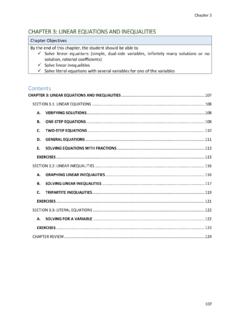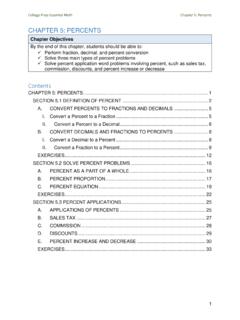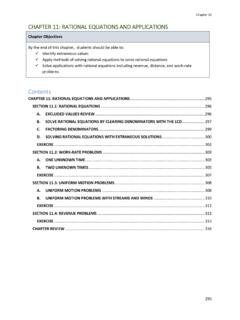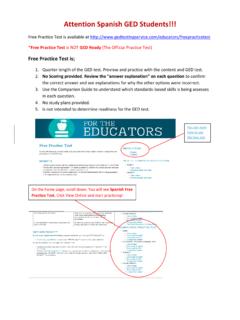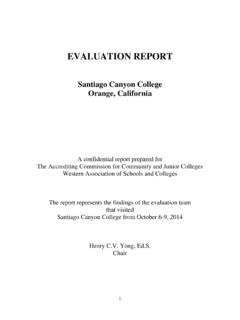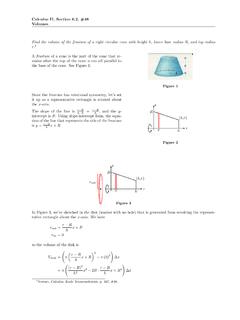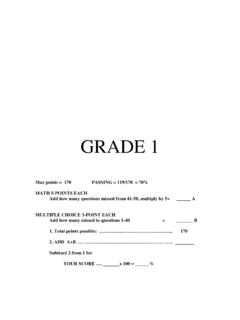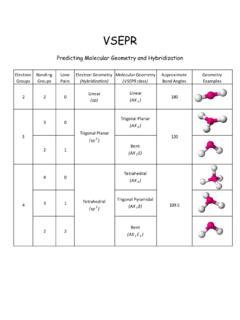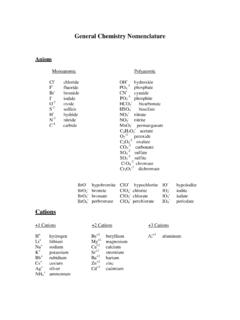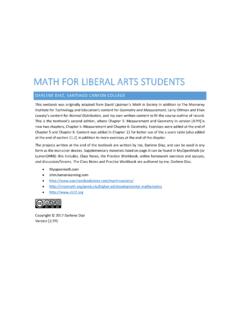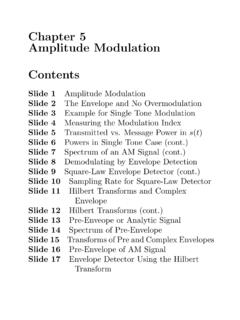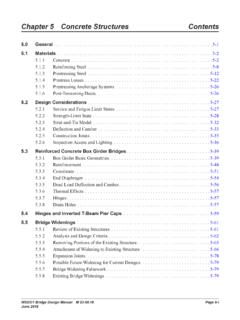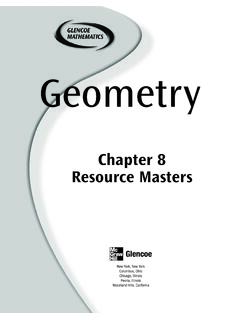Transcription of CHAPTER 12: RADICALS Contents - Santiago Canyon College
1 CHAPTER 12 317 CHAPTER 12: RADICALS CHAPTER Objectives By the end of this CHAPTER , students should be able to: Simplify radical expressions Rationalize denominators (monomial and binomial) of radical expressions Add, subtract, and multiply radical expressions with and without variables Solve equations containing RADICALS Contents CHAPTER 12: RADICALS .. 317 SECTION INTRODUCTION TO RADICALS .. 319 A. INTRODUCTION TO PERFECT SQUARES AND PRINCIPAL SQUARE ROOT .. 319 B. INTRODUCTION TO RADICALS .. 320 C. SIMPLIFY RADICALS WITH PERFECT PRINCIPAL ROOT .. 322 D. SIMPLIFY RADICALS WITH PERFECT PRINCIPAL ROOT USING EXPONENT RULE.
2 323 E. SIMPLIFY RADICALS WITH NO PERFECT ROOT .. 325 F. SIMPLIFY RADICALS WITH COEFFICIENTS .. 326 G. SIMPLIFY RADICALS WITH VARIABLES WITH NO PERFECT RADICANTS .. 327 EXERCISE .. 328 SECTION : ADD AND SUBTRACT RADICALS .. 329 A. ADD AND SUBTRACT LIKE RADICALS .. 329 B. SIMPLIFY, THEN ADD AND SUBTRACT LIKE RADICALS .. 330 EXERCISE .. 331 SECTION : MULTIPLY AND DIVIDE RADICALS .. 332 A. MULTIPLY RADICALS WITH MONOMIALS .. 332 B. DISTRIBUTE WITH RADICALS .. 334 C. MULTIPLY RADICALS USING FOIL .. 335 D. MULTIPLY RADICALS WITH SPECIAL-PRODUCT FORMULAS .. 336 E. SIMPLIFY QUOTIENTS WITH RADICALS .
3 337 EXERCISE .. 339 SECTION : RATIONALIZE DENOMINATORS .. 341 A. RATIONALIZING DENOMINATORS WITH SQUARE ROOTS .. 341 B. RATIONALIZING DENOMINATORS WITH HIGHER ROOTS .. 342 C. RATIONALIZE DENOMINATORS USING THE CONJUGATE .. 343 EXERCISE .. 345 SECTION : RADICAL EQUATIONS .. 346 CHAPTER 12 318 A. RADICAL EQUATIONS WITH SQUARE ROOTS .. 346 B. RADICAL EQUATIONS WITH TWO SQUARE ROOTS .. 348 C. RADICAL EQUATIONS WITH HIGHER ROOTS .. 351 EXERCISE .. 352 CHAPTER REVIEW .. 353 CHAPTER 12 319 SECTION INTRODUCTION TO RADICALS A. INTRODUCTION TO PERFECT SQUARES AND PRINCIPAL SQUARE ROOT MEDIA LESSON Introduction to square roots (Duration 7:03 ) View the video lesson, take notes and complete the problems below Some numbers are called _____.
4 It is important that we can recognize _____ when working with square roots. 12=1 1= _____ 62=6 6=_____ 22=2 2= _____ 72=7 7= _____ 32=3 3= _____ 82=8 8=_____ 42=4 4= _____ 92=9 9 =_____ 52=5 5= _____ 102=10 10 =_____ To determine the square root of a number, we have a special symbol. 9 The square root of a number is the number times itself that equals the given number. 9 = _____ 36 = _____ 49 = _____ 81 =_____ You can think of the square root as the opposite or inverse of squaring. Actually, numbers have two square roots. One is positive and one is negative. 5 5 =25 and 5 5 =25 To avoid confusion 25=5 and 25= 5 What about these square roots?
5 20 61 CHAPTER 12 320 YOU TRY a) Find the perfect square of: 112 = _____ 122= _____ 132 = _____ 142= _____ 152= _____ 162= _____ 172= _____ 182= _____ 192=_____ 202=_____ b) Find the square root of: 441= _____ 484=_____ 529=_____ 576=_____ 625=_____ 676=_____ 729=_____ 784=_____ 841= _____ 900= _____ MEDIA LESSON Principal nth square roots vs. general square roots (Duration 5:23 ) Note: In this class, we will only consider the principal roots when we discuss RADICALS .
6 B. INTRODUCTION TO RADICALS RADICALS are a common concept in algebra. In fact, we think of RADICALS as reversing the operation of an exponent. Hence, instead of the square of a number, we square root a number; instead of the cube of a number, we cube root a number to reverse the square to find the base. Square roots are the most common type of radical used in algebra. Definition If is a positive real number, then the principal square root of a number is defined as = if and only if = The is the radical symbol, and is called the radicand. If given something like , then 3 is called the root or index; hence, is called the cube root or third root of.
7 In general, = if and only if = If is even, then and must be greater than or equal to zero. If is odd, then and must be any real number. Here are some examples of principal square roots: 1=1 121=11 4=2 625=25 9=3 81 is not a real number The final example 81 is not a real number. Since square root has the index is 2, which is even, the radicand must be greater than or equal to zero and since 81<0, then there is no real number in which we can square and will result in 81, , ?2= 81. So, for now, when we obtain a radicand that is negative and the root is even, we say that this number is not a real number.
8 There is a type of number where we can evaluate these numbers, but just not a real one. CHAPTER 12 321 MEDIA LESSON Introduction to square roots, cube roots, and Nth roots (Duration 9:09) View the video lesson, take notes and complete the problems below The principal root of is the root that has the same sign as , and it is denoted by the radical symbol. We read this as the _____ , _____ , or _____ . The positive integer _____ of the radical. If =2, _____ the index. The number _____. 4=_____ 164=_____ 4=_____ 164=_____ Square roots (n = 2) 1=_____ 1=_____ 4= _____ 4= _____ 9= _____ 9= _____ 16= _____ 16= _____ 25= _____ 25= _____ Cube roots (n = 3) 13= _____ 13= _____ 83= _____ 83= _____ 273=_____ 273=_____ 643 = _____ 643 = _____ 1253=_____ 1253=_____ Example: Simplify 1) 36= 2) 81 = 3) 49 = 4) 643 = 5) 325= 6) 83 = CHAPTER 12 322 Inverse properties of Powers and Roots If has a principal root, then_____.
9 If is odd, then _____. If is even, then _____. We need the _____ for any root with an _____ exponent for which the index is _____ to assure the root is _____. Example: Simplify 1) 2 2) 93 3) 84 4) 124 C. SIMPLIFY RADICALS WITH PERFECT PRINCIPAL ROOT MEDIA LESSON Simplify perfect roots (Duration 4:04 ) View the video lesson, take notes and complete the problems below Example: a) 81 b) 273 c) 164 d) 243 CHAPTER 12 323 MEDIA LESSON Simplify perfect roots negative radicands (Duration 4:32 ) View the video lesson, take notes and complete the problems below Example: Simplify each of the following.
10 A) 164= _____ b) 325= _____ c) 646= _____ YOU TRY Simplify. Show your work. a) 36 b) 64 3 c) 6254 d) 15 D. SIMPLIFY RADICALS WITH PERFECT PRINCIPAL ROOT USING EXPONENT RULE There is a more efficient way to find the root by using the exponent rule but first let s learn a different method of prime factorization to factor a large number to help us break down a large number into primes.
